
Kudos has partnered with CardRatings and Red Ventures for our coverage of credit card products. Kudos, CardRatings, and Red Ventures may receive a commission from card issuers. Kudos may receive commission from card issuers. Some of the card offers that appear on Kudos are from advertisers and may impact how and where card products appear on the site. Kudos tries to include as many card companies and offers as we are aware of, including offers from issuers that don't pay us, but we may not cover all card companies or all available card offers. You don't have to use our links, but we're grateful when you do!
Best Metal Credit Cards in 2025 – Are They Worth the Hype?
July 1, 2025


Metal credit cards promise prestige, premium perks, and rewards that outshine their plastic counterparts. But with annual fees ranging from $0 to $895, how do you know if upgrading to metal actually pays off? The truth is shocking: the average cardholder leaves $624 in unused card benefits on the table each year, according to Kudos Insights data. That means many people pay for premium metal cards but never claim the lounge access, travel credits, or statement credits they're entitled to.
This guide cuts through the marketing hype to reveal which metal credit cards deliver real value in 2025. You'll discover the top 5 metal cards across different spending profiles—from luxury travelers chasing airport lounge access to everyday shoppers maximizing grocery rewards. We'll break down the math on when a $695 annual fee actually saves you money, which cards grant you access to over 1,400 airport lounges worldwide, and how to avoid common pitfalls like paying for perks you'll never use.
Whether you're eyeing the iconic titanium of the American Express Platinum or wondering if a no-fee metal card exists, you'll learn exactly which card matches your lifestyle—and how to squeeze every dollar of value from it.
What Makes Metal Cards Different (And Why It Matters)
Metal credit cards aren't just about aesthetics—they signal something important in the credit card industry. Banks reserve metal construction for their premium products, which means these cards typically bundle high-value perks like airport lounge access, comprehensive travel insurance, and generous statement credits.
The Metal Card Hierarchy:
- Ultra-Premium Metal ($500+ annual fee): Titanium or stainless steel, 15-18+ grams, packed with luxury travel benefits
- Mid-Premium Metal ($95-$400 annual fee): Metal composite construction, strong travel rewards and select perks
- No-Fee Metal ($0 annual fee): Lightweight metal alloy, solid everyday rewards without luxury extras
Why Banks Use Metal: The heavier weight and premium feel create a tangible reminder of the card's value every time you use it. More importantly, metal cards are more durable—they survive washing machines and years of daily use better than plastic alternatives.
The Real Question: Should you choose a card because it's metal? Absolutely not. Choose it because the rewards and benefits align with your spending. The metal construction is simply a nice bonus that comes with cards offering genuinely valuable perks.
The Hidden Math - When Premium Fees Actually Save Money
Here's the counterintuitive truth: A $695 annual fee can be cheaper than a $95 fee—if you use the right benefits. Let's break down the math with a real example.
Premium Card Value Breakdown (American Express Platinum Card®):
- Annual fee: $895 (See Rates & Fees)
Break-Even Analysis: If you use just $695 worth of these credits, the card has no additional cost. Use more, and you're actually making money on the annual fee.
The Catch: This only works if these credits align with your existing spending. Don't change your habits just to use credits—that defeats the purpose of saving money.
Lower-Fee Alternative Math: Cards like the Chase Sapphire Preferred® Card charge $95 annually but offer $50 worth of hotel credit when you book through Chase Travel℠, effectively reducing the fee to $45 for travelers. For frequent travelers earning 5x points on Chase Travel bookings, the card can generate hundreds more in value than its cost.
Bottom Line: Before signing up for any premium metal card, map your typical spending to the card's benefits. If the alignment is strong, high annual fees become invisible. If not, you're just paying for presks you won't use.
Airport Lounge Access Explained - Your $400+ Hidden Benefit
One of the most valuable—and underused—perks of premium metal cards is airport lounge access. If you travel even just 4-5 times per year, lounge access alone can justify a card's annual fee.
What Is Lounge Access Worth?A single Priority Pass lounge visit costs $32-$35 when purchased à la carte. Premium metal cards grant you unlimited access to networks of 1,000+ lounges worldwide—potentially saving $400-$800 annually for moderate travelers.
The Major Lounge Networks:
1. American Express Global Lounge Collection (Amex Platinum)
- Over 1,400 lounges worldwide
- Includes exclusive Centurion Lounges (premium amenities, complimentary food & drinks)
- Priority Pass Select membership
- Delta Sky Club access (10 visits when flying Delta)
- Escape Lounges, Plaza Premium, and more
2. Capital One Lounge Access (Capital One Venture X Rewards Credit Card)
- Capital One Lounges in major hubs (Dallas, Denver, Washington, with more coming)
- Priority Pass membership with unlimited guest access
- Plaza Premium Lounge network access
3. Chase Lounge Program (Sapphire Reserve)
- Priority Pass Select
- 1,500+ lounges globally
- Includes Chase Sapphire Lounges (Hong Kong, select US airports)
The Guest Policy Advantage: Some cards let you bring guests for free (Capital One Venture X), while others charge per guest (typically $32). If you travel with family, guest policies become crucial for maximizing value.
Pro Tip: Even if your home airport doesn't have a premium lounge, most major connecting hubs do. That 3-hour layover suddenly becomes productive time with WiFi, power outlets, and complimentary snacks instead of overpriced airport food.
The 5 Best Metal Credit Cards of 2025
Card #1: Chase Sapphire Preferred® Card - Best Overall Value
Annual Fee: $95
Best For: Frequent travelers and dining enthusiasts seeking premium rewards without ultra-premium fees
The Chase Sapphire Preferred® Card proves you don't need a $500+ annual fee to get substantial travel rewards and metal card prestige. This card strikes the ideal balance for most travelers—premium enough to feel valuable, affordable enough to justify easily.
Key Benefits:
- No foreign transaction fees—crucial for international travelers
- Primary rental car coverage (up to the vehicle's cash value)
- Trip cancellation and interruption insurance
- Baggage delay insurance
- 1:1 point transfer to 14+ airline and hotel partners (United, Southwest, Hyatt, Marriott, and more)
The Value Calculation: With your first annual fee at $95, if you earn the welcome bonus and book that $938 travel redemption, you've already gained $843 in value your first year—even before counting ongoing rewards.
What's Missing: No airport lounge access and no luxury statement credits. For those perks, you'd need the pricier Sapphire Reserve.
Who Should Get This: Travelers who dine out 2-3+ times weekly and take 2-4 trips per year. If you're not flying every month, Sapphire Preferred's lower fee makes more sense than ultra-premium alternatives.
[[ SINGLE_CARD * {"id": "509", "isExpanded": "false", "bestForCategoryId": "15", "bestForText": "Frequent Travelers", "headerHint": "Exceptional Travel Value"} ]]
Card #2: American Express Platinum Card® - Best for Luxury Travel
Annual Fee: $895 (See Rates & Fees)
Best For: Frequent flyers who will fully utilize premium travel benefits and statement credits
The American Express® Platinum Card is the flagship luxury metal card—18.5 grams of titanium that grants you access to more airport lounges than any other consumer card. At $895 annually, it's expensive—but the benefits can far exceed the fee for the right traveler.
The Lounge Advantage:
Access to 1,400+ airport lounges globally through:
- Centurion Lounges (premium Amex-operated lounges with complimentary food, drinks, and spa services)
- Delta Sky Club access (10 complimentary visits when flying Delta)
- Priority Pass Select membership
- Escape Lounges, Plaza Premium, and international lounge partners
The Reality Check: This card only makes sense if you'll actually use the credits. If you're not flying monthly, shopping at Saks, or dining at partner restaurants, you're paying $695 for benefits you'll ignore, making this an expensive paperweight.
Who Should Get This: Business travelers and luxury seekers who fly 10+ times per year, value airport lounge access, and will legitimately use the dining and shopping credits. This card rewards high-travel lifestyles.
[[ SINGLE_CARD * {"id": "106", "isExpanded": "false", "bestForCategoryId": "15", "bestForText": "Frequent Travelers", "headerHint": "Serious Points on Flights"} ]]
Terms apply to American Express benefits and offers. Enrollment may be required for select American Express benefits and offers. Visit americanexpress.com to learn more. Eligibility and Benefit level varies by Card. Terms, Conditions, and Limitations Apply. Please visit americanexpress.com/benefitsguide for more details. Underwritten by Amex Assurance Company.
Card #3: Capital One Venture X Rewards Credit Card - Best Flexible Travel Rewards
Annual Fee: $395
Best For: Travelers who want premium perks at a mid-premium price point
The Capital One Venture X Rewards Credit Card is Capital One's answer to premium travel cards—offering lounge access and strong travel rewards for $300 less than the Amex Platinum. It's ideal for travelers who want flexibility over luxury.
Lounge Access:
- Capital One Lounge access (Dallas, Denver, Washington Dulles, with Las Vegas coming 2025)
- Priority Pass with unlimited guest access (a major perk—most cards charge $32/guest)
- Plaza Premium Lounge access
Transfer Partners: 1:1 transfers to 15+ airline and hotel partners, including Air Canada Aeroplan, Air France-KLM, British Airways, Emirates, Turkish Airlines, and more.
Who Should Get This: Travelers who value simplicity and lounge access but don't need the extensive statement credits of Amex Platinum. Perfect for international travelers who want flexibility in redeeming miles.
[[ SINGLE_CARD * {"id": "2888", "isExpanded": "true", "bestForCategoryId": "52", "bestForText": "Frequent Travelers", "headerHint" : "Luxurious Travel Benefits" } ]]
Card #4: Apple Card - Best No-Annual-Fee Metal Card
Annual Fee: $0
Best For: iPhone users seeking simple cash back and a no-fee metal card experience
Who says metal cards require high annual fees? The Apple Card proves otherwise—offering titanium construction and clean cash back rewards with zero annual fee.
What Makes It Different:
- Daily Cash: Unlike most cards that pay monthly, Apple Card gives you cash back daily
- Privacy First: The physical card has no visible number—everything lives securely in your iPhone's Wallet app
- Smart Tools: The Wallet app shows spending by category and merchant, helping you track where your money goes
- No Fees: No annual fee, no foreign transaction fees, no late fees, and no over-limit fees
The Reality Check: While 1% cash back on physical card swipes is low, most iPhone users primarily use Apple Pay (earning 2%)—making this a solid everyday card for the Apple ecosystem.
Who Should Get This: Apple enthusiasts and minimalists who want the prestige of a metal card without complex rewards structures or annual fees. It's also excellent as a secondary card for Apple purchases and Apple Pay transactions.
[[ SINGLE_CARD * {"id": "145", "isExpanded": "false", "bestForCategoryId": "52", "bestForText": "Apple Pay Users", "headerHint" : "No Annual Fee" } ]]
Card #5: Prime Visa - Best for Amazon Shoppers (No Annual Fee)
Annual Fee: $0 (requires Amazon Prime membership at $139/year)
Best For: Heavy Amazon shoppers and families doing significant grocery shopping at Whole Foods
The Prime Visa turns every Amazon order into a 5% discount—and it's made of metal. For the millions of U.S. households that already pay for Amazon Prime, this card is an obvious choice.
The Value Calculation: If your household spends $500/month on Amazon and Whole Foods ($6,000/year), you'll earn $300 cash back annually—on top of your existing Prime benefits. That's serious value for a card with no annual fee.
Additional Benefits:
- No foreign transaction fees
- Visa Signature benefits (travel accident insurance, purchase protection)
- Zero fraud liability
- Extended warranty protection
The Catch: If you cancel Prime, your earning rate drops to 3% on Amazon/Whole Foods. And outside the Amazon ecosystem, 2% at restaurants and gas is decent but not category-leading.
Who Should Get This: Families who shop heavily on Amazon or at Whole Foods. If you're already paying $139 for Prime and spending $300+ monthly at Amazon/Whole Foods, this metal card delivers hundreds in annual cash back with zero additional fees.
[[ SINGLE_CARD * {"id": "79", "isExpanded": "false", "bestForCategoryId": "15", "bestForText": "Frequent Amazon Shoppers", "headerHint": "Impressive Rewards and Benefits"} ]]
How to Actually Use Metal Card Benefits (Without Leaving Money Behind)
Choosing the right metal card is step one. Actually using its benefits is step two—and where most people fail. Remember that $624 figure? That's how much the average cardholder leaves unused annually, according to Kudos Insights research.
The 3 Most Commonly Wasted Benefits:
1. Statement Credits
Cards like Amex Platinum offer up to $100 Saks credit, $209 CLEAR credit, and up o $200 airline fee credit. If you don't shop at Saks or use CLEAR, that's $289 in wasted value immediately.
Solution: Before applying for premium cards, honestly assess whether you'll use statement credits. If you never fly, airline fee credits are worthless. If you don't shop at luxury retailers, Saks credits go unused.
2. Airport Lounge Access
Many cardholders pay for lounge access through high annual fees but never actually visit lounges—either because they forget or don't know which lounges their card grants access to.
Solution: Download the Priority Pass or lounge network app before your trip. Check which lounges are available at your departure and connection airports. Add lounge visits to your pre-flight routine—arriving 30 minutes earlier for a complimentary meal and WiFi can transform your travel experience.
3. Travel Insurance and Purchase Protection
Premium metal cards bundle comprehensive travel insurance (trip delay, baggage loss, rental car coverage) and purchase protection—benefits worth thousands if you ever need them. But most cardholders don't even know they exist.
Solution: Keep a copy of your card's benefit guide in your travel bag or saved in your phone. If your flight is delayed 6+ hours, your Sapphire Preferred covers $500 in expenses—but only if you know to file a claim.
The Kudos Solution:
This is exactly why Kudos created Hidden Perks—a feature that automatically tracks your credit card benefits and alerts you when credits are about to expire or when you're using the wrong card. Instead of manually tracking dozens of perks across multiple cards, Kudos does it for you. The average Kudos user recovers $441 annually in previously missed rewards and benefits.
The Metal Card Application Process - What to Expect
Getting approved for a premium metal credit card requires more than just decent credit. Here's what issuers actually look for:
Credit Score Requirements:
- Ultra-Premium Cards (Amex Platinum, Venture X): Excellent credit typically required (720+ FICO)
- Mid-Premium Cards (Sapphire Preferred): Good to excellent credit (690+ FICO)
- No-Fee Metal Cards (Apple Card, Prime Visa): Good credit (660+ FICO), though approval ranges vary
Beyond Credit Score - What Issuers Consider:
- Income: Premium cards often require $50,000+ annual income (though this varies)
- Existing Relationship: Having deposit accounts or other cards with the issuer can help
- Credit Utilization: Keep balances below 30% of limits before applying
- Recent Applications: Too many recent credit inquiries can hurt approval odds
The Soft vs. Hard Pull Difference: Some cards let you check pre-qualification with a soft credit pull (won't affect your score). If you're approved after the full application, that triggers a hard inquiry (typically -5 points temporarily).
Strategy for Beginners: If you have limited credit history, start with a no-fee metal card like Apple Card (which uses soft pulls for pre-approval). Build payment history for 6-12 months, then apply for premium travel cards.
The 5/24 Rule (Chase Cards): Chase typically won't approve you if you've opened 5+ credit cards across any issuer in the past 24 months. If you're considering Sapphire Preferred, apply for Chase cards before hitting this threshold.
Red Flags - When Metal Cards Become Money Traps
Premium metal cards aren't for everyone—and aggressive marketing can obscure the downsides. Watch for these warning signs that a metal card might cost you more than it's worth:
Red Flag #1: You're Not Using Enough Credits to Offset the Fee
If your $695 Amex Platinum sits in your wallet while $2,000 in annual credits expire unused, you're paying $895 for... metal. That's an expensive paperweight.
Reality Check: Track your first 3 months of credit usage. If you're consistently missing statement credits or not visiting airport lounges, downgrade to a lower-fee card before year two hits.
Red Flag #2: You're Changing Spending Habits to "Justify" Benefits
Some people start shopping at Saks or booking unnecessary flights just to use credits. That's not saving money—that's spending money you wouldn't normally spend to activate benefits you're already paying for.
Reality Check: Credits should align with existing spending patterns. Don't force it.
Red Flag #3: You're Carrying a Balance
Premium metal cards typically have APRs ranging from 18.99% to 29.99% variable. If you're carrying a balance month-to-month, interest charges will instantly erase any rewards value.
Reality Check: If you can't pay your full statement balance monthly, rewards cards—metal or not—are the wrong tool. Focus on 0% APR balance transfer cards instead.
Red Flag #4: You Applied Because It "Looks Cool"
Metal cards are designed to feel prestigious. But paying $395-$695 annually for aesthetics is expensive vanity. Choose cards for benefits first, metal second.
Comparing Metal Cards Side-by-Side
Here's how the top 5 metal cards stack up across key metrics:
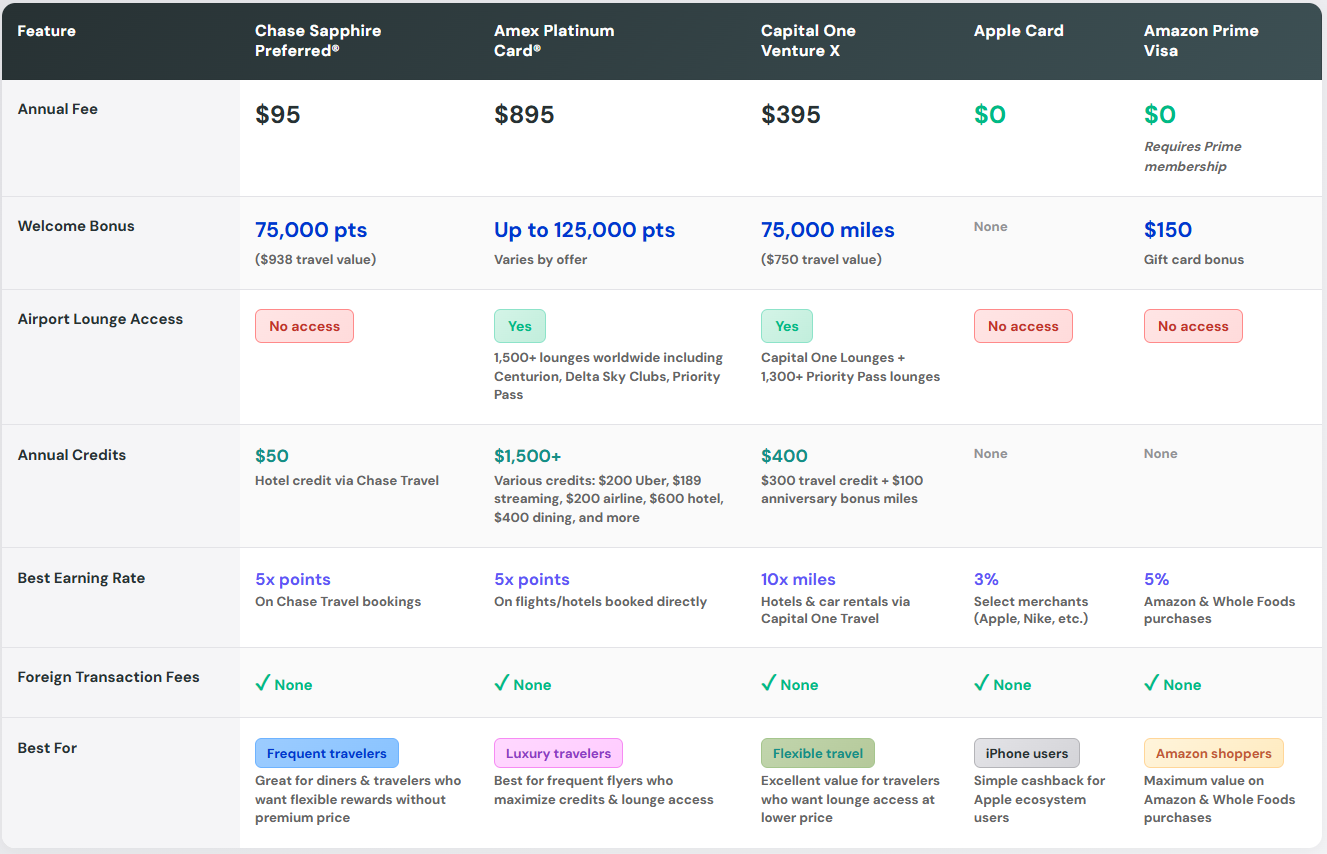
The Verdict: No single "best" card exists—only the best card for your spending. Map your annual expenses to these categories to identify your ideal match.
Expert Tips - Maximizing Metal Card Value
Tip #1: Stack Benefits Across Cards
You don't have to choose just one metal card. Strategic combinations can multiply value:
Tip #2: Use Transfer Partners Wisely
Cards with transfer partners (Sapphire Preferred, Venture X, Amex Platinum) offer 30-50% more value when you transfer points to airlines rather than redeeming for cash back. A 75,000-point welcome bonus could be worth $1,125+ in premium flight redemptions versus $750 cash.
Tip #3: Time Your Application for Welcome Bonuses
If you have a big purchase coming (wedding, home renovation, business expense), time your card application 4-6 weeks before. You'll hit minimum spend requirements naturally without forcing spending.
Tip #4: Set Calendar Reminders for Credit Expirations
Most statement credits reset semi-annually or annually. Set phone reminders 2 weeks before expiration so you don't lose credits.
Tip #5: Let Kudos Do the Heavy Lifting
Rather than manually tracking which card earns what at every merchant, Kudos recommends the best card at checkout automatically. It's like having a rewards optimizer in your pocket—helping you earn 10-15% more rewards simply by using the right card.
FAQs - Metal Credit Cards Answered
What is a metal credit card?
A metal credit card is a payment card constructed with metal (typically stainless steel, titanium, or metal alloy) instead of plastic. The metal construction makes the card heavier and more durable. Banks often reserve metal cards for premium products with high-value rewards and benefits. From a functional standpoint, metal cards work identically to plastic—they just feel more premium.
Are metal credit cards better than plastic cards?
Not inherently. Metal cards aren't automatically superior—the benefits matter more than the material. However, metal cards tend to correlate with premium perks because banks use them to differentiate high-tier offerings. Metal cards are more durable and less likely to crack or wear over time compared to plastic. But a plastic card with better rewards will always outperform a metal card with weak benefits.
Can I get a metal credit card with no annual fee?
Yes. The Apple Card and Prime Visa both offer metal construction with $0 annual fee. These cards provide solid everyday rewards without luxury travel perks. While they lack airport lounge access and statement credits, they're excellent for users who want metal card prestige without ongoing costs.
How do I dispose of a metal credit card?
Don't use scissors or shredders—metal cards are too durable and can damage equipment. Instead, contact your card issuer and request a prepaid envelope for secure destruction. Most banks will send you one when your card expires or when you close the account. Some issuers also accept in-person returns at branch locations.
Do metal credit cards set off airport security?
Rarely. A single metal card doesn't contain enough metal to trigger most modern metal detectors. TSA typically has you place wallets in screening bins anyway. If you're concerned, simply place your wallet in the tray during security screening—the same as you would with keys or coins.
Which metal card has the best airport lounge access?
American Express® Platinum Card offers the most extensive lounge network—over 1,400 lounges globally through the Centurion Lounge network, Delta Sky Club access, Priority Pass, and more. Capital One Venture X also offers strong lounge access with Priority Pass and growing Capital One Lounges. Chase Sapphire Preferred doesn't include lounge access—you'd need Sapphire Reserve for that perk.
Can I have multiple premium metal cards?
Yes, and many rewards enthusiasts do exactly this—strategically holding 2-3 cards to maximize category bonuses. Just ensure each card's annual fee is justified by the benefits you actually use. Holding multiple premium cards only makes sense if you're actively earning enough rewards to offset the combined annual fees.
What credit score do I need for a metal credit card?
This varies by card tier. Ultra-premium cards like Amex Platinum typically require excellent credit (720+ FICO). Mid-premium cards like Chase Sapphire Preferred generally need good to excellent credit (690+ FICO). No-fee options like Apple Card may approve good credit (660+ FICO), though ranges vary. Beyond credit score, issuers also consider income, existing relationships, and recent credit applications.
Bottom Line: Is Metal Worth It?
The appeal of metal credit cards isn't about the material—it's about the benefits that typically come with them. The question isn't "Should I get a metal card?" but rather "Do this card's perks align with my actual spending?"
Get a Premium Metal Card If:
- You travel frequently enough to use lounge access (6+ flights yearly makes this worthwhile)
- You'll legitimately use statement credits without forcing spending habits
- The welcome bonus alone covers the first-year annual fee
- You understand how to maximize transfer partners for premium redemptions
Skip Premium Metal Cards If:
- You rarely travel or prefer driving to flying
- You'll carry balances (interest charges erase reward value instantly)
- You can't commit to tracking credit expirations
- You're attracted primarily to aesthetics rather than benefits
Start with No-Fee Metal If:
- You want the premium feel without annual fee risk
- You're building credit history before applying for ultra-premium cards
- You're an iPhone user (Apple Card) or heavy Amazon shopper (Prime Visa)
The Kudos Advantage:
Whichever metal card you choose, Kudos helps you maximize its value automatically. Rather than manually tracking expiring credits, lounge locations, and category bonuses, Kudos handles the optimization for you—recommending the right card at checkout and alerting you to unused benefits before they expire. The average Kudos user earns $441 more annually simply by using the right card at the right time.
Ready to upgrade your wallet? Explore all metal credit cards on Kudos to find your perfect match—and use code GET20 to earn $20 back on your first eligible purchase when you sign up.
The metal card revolution has democratized premium perks—making airport lounges, comprehensive travel insurance, and serious rewards accessible beyond the ultra-wealthy. Choose strategically, use benefits fully, and that metal card becomes one of your wallet's most valuable tools.
Unlock your extra benefits when you become a Kudos member

Turn your online shopping into even more rewards

Join over 400,000 members simplifying their finances

Editorial Disclosure: Opinions expressed here are those of Kudos alone, not those of any bank, credit card issuer, hotel, airline, or other entity. This content has not been reviewed, approved or otherwise endorsed by any of the entities included within the post.
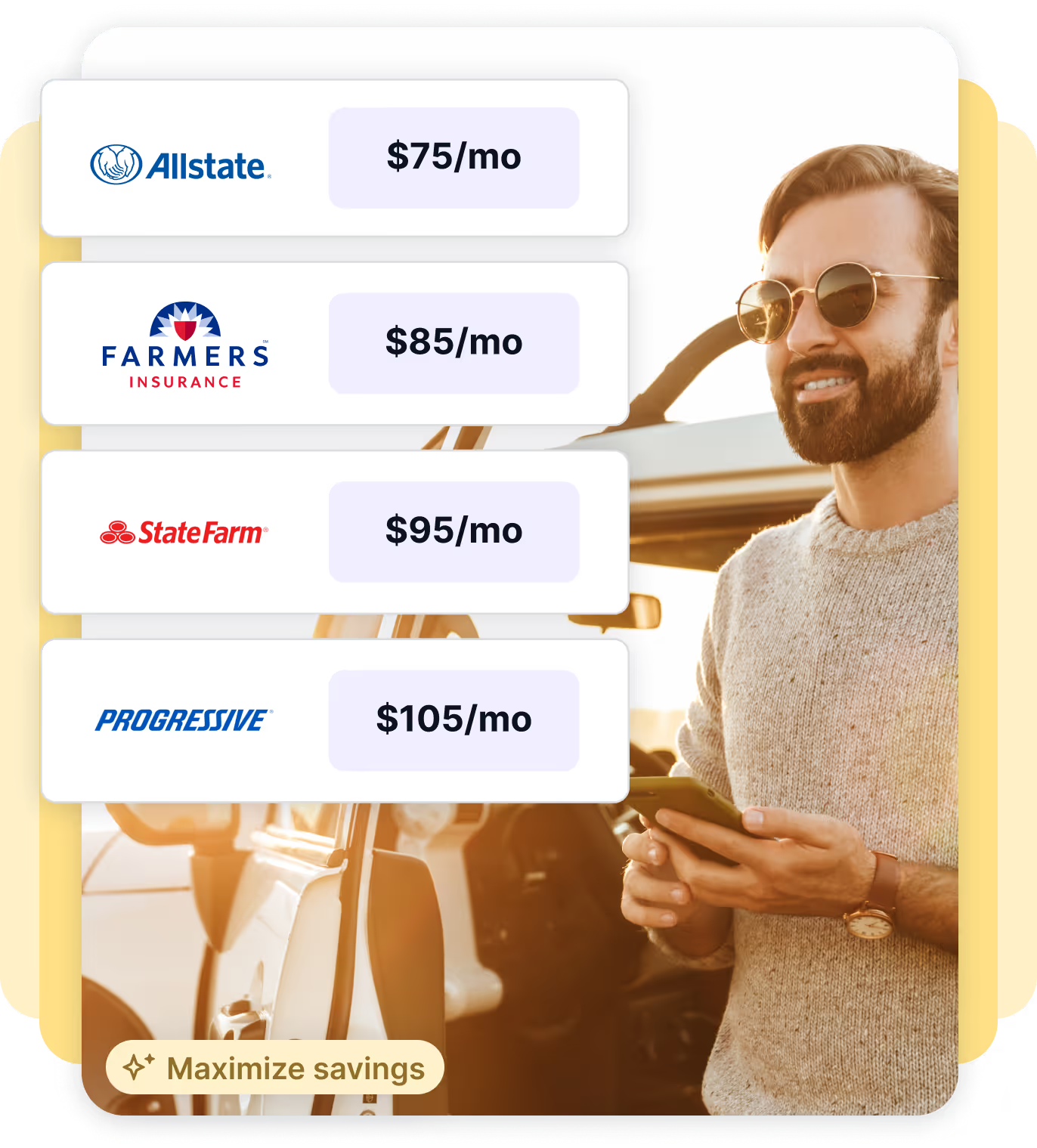

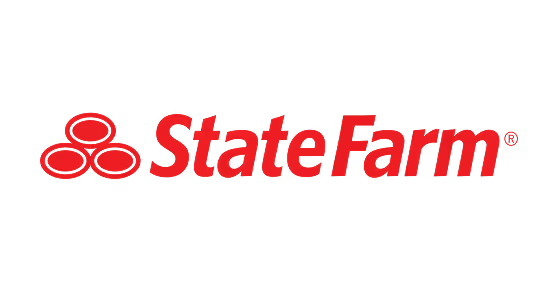
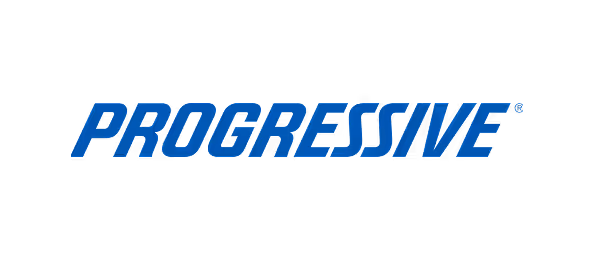






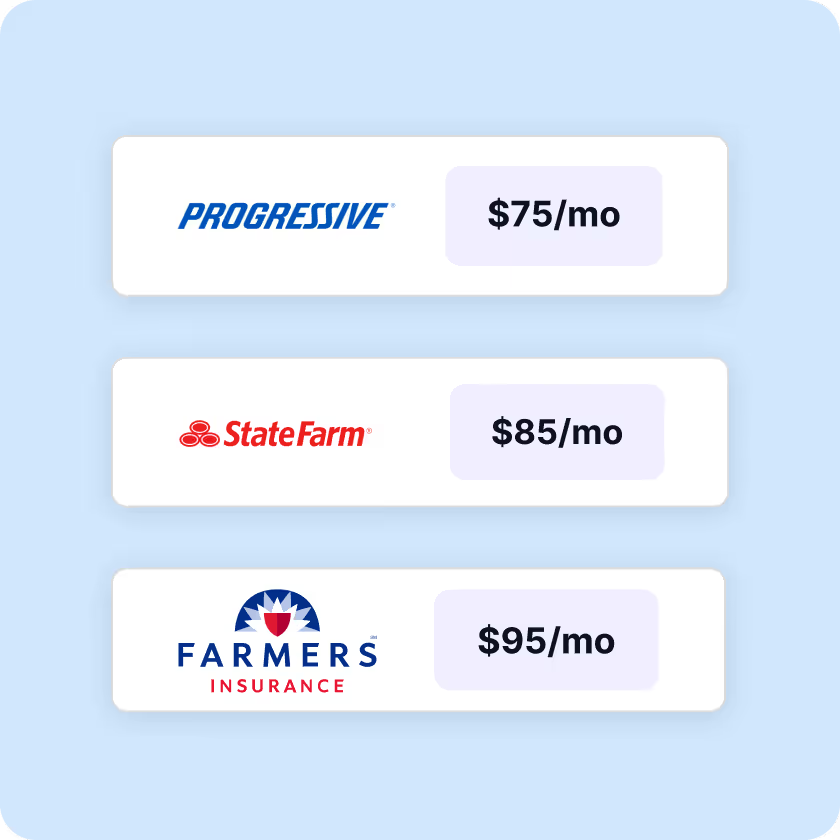








.webp)















.webp)


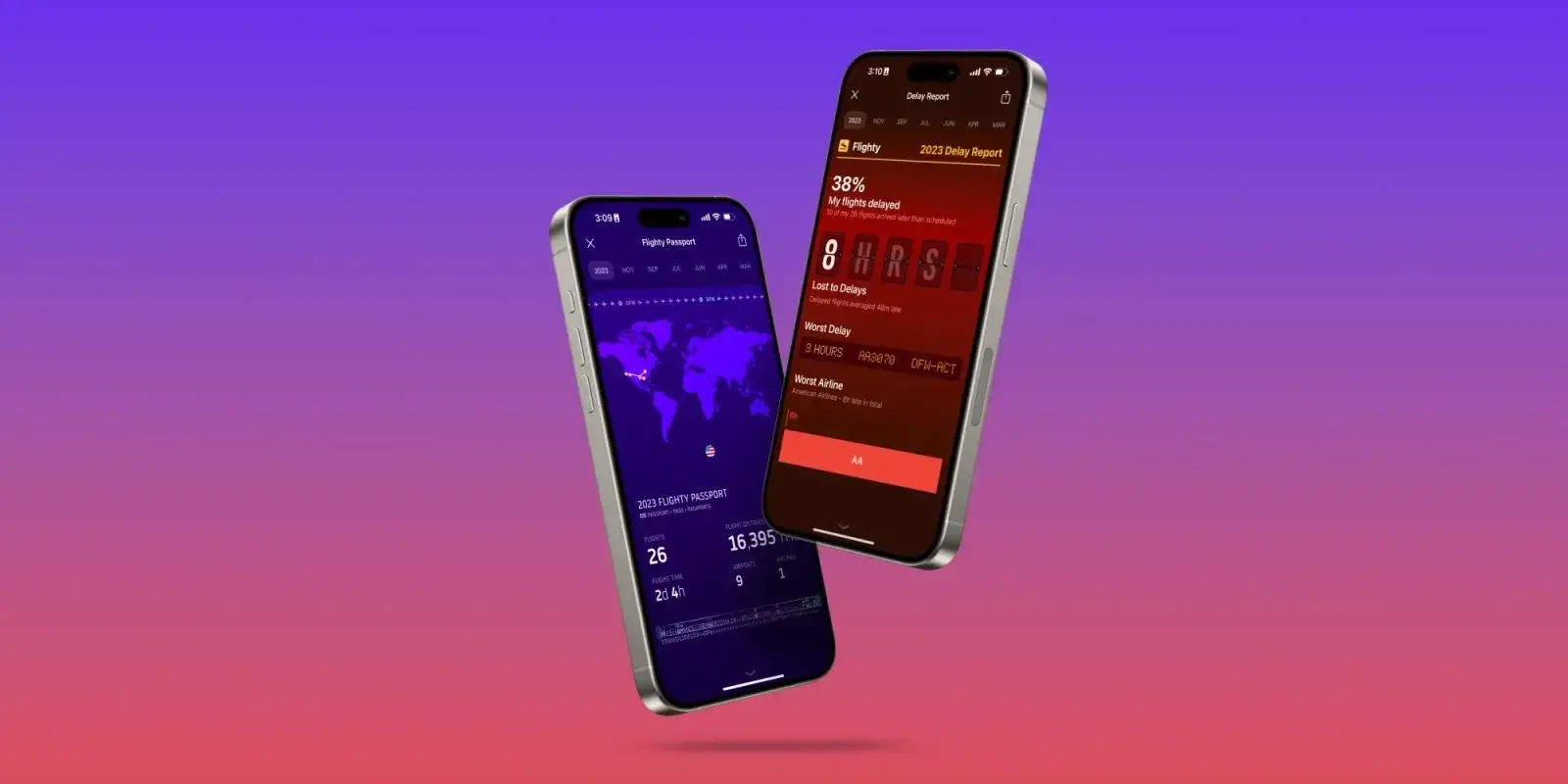
.webp)




